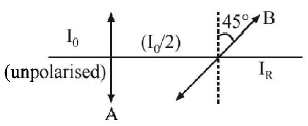Question
A beam of unpolarised light of intensity $${{I_0}}$$ is passed through a polaroid $$A$$ and then through another polaroid $$B$$ which is oriented so that its principal plane makes an angle of 45° relative to that of $$A.$$ The intensity of the emergent light is
A.
$${{I_0}}$$
B.
$$\frac{{{I_0}}}{2}$$
C.
$$\frac{{{I_0}}}{4}$$
D.
$$\frac{{{I_0}}}{8}$$
Answer :
$$\frac{{{I_0}}}{4}$$
Solution :
Relation between intensities

$$\eqalign{ & {I_r} = \left( {\frac{{{I_0}}}{2}} \right){\cos ^2}\left( {{{45}^ \circ }} \right) \cr & = \frac{{{I_0}}}{2} \times \frac{1}{2} \cr & = \frac{{{I_0}}}{4} \cr} $$
Relation between intensities

$$\eqalign{ & {I_r} = \left( {\frac{{{I_0}}}{2}} \right){\cos ^2}\left( {{{45}^ \circ }} \right) \cr & = \frac{{{I_0}}}{2} \times \frac{1}{2} \cr & = \frac{{{I_0}}}{4} \cr} $$